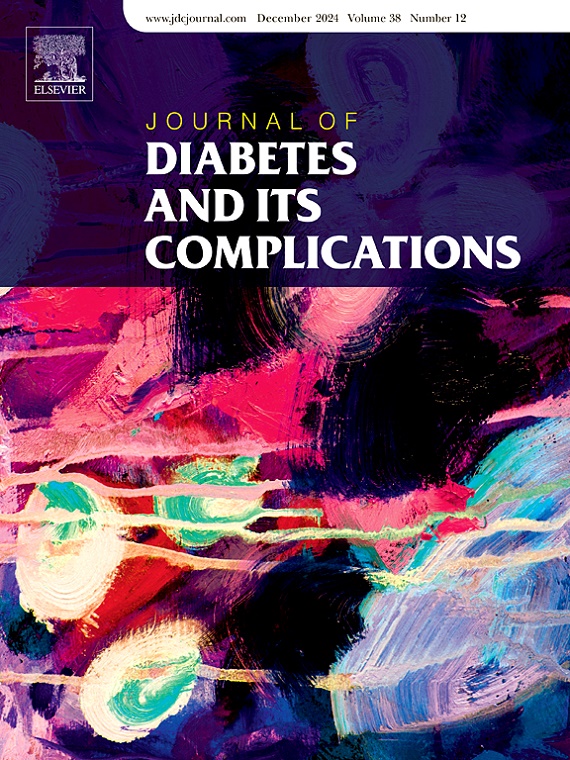Associations of three diagnostic glycemic measures with all-cause and cardiovascular mortality in people not on antidiabetic medications: A prospective cohort study
IF 2.9
3区 医学
Q3 ENDOCRINOLOGY & METABOLISM
引用次数: 0
Abstract
Objective
This study aimed to investigate the value of three diagnostic glycemic measures, i.e., 2-hour plasma glucose (2hPG) during 75-g oral glucose tolerance test, fasting plasma glucose (FPG), and glycated hemoglobin (HbA1c), in predicting risk of all-cause and cardiovascular mortality after adjusting for the influence of these glycemic measures on each other.
Methods
A total of 14,013 U.S. adults who were not on antidiabetic medications when recruited were identified from the Third National Health and Nutrition Examination Survey (NHANES III) and NHANES 2005–2016. High blood glucose was defined as 2hPG ≥11.1 mmol/L, FPG ≥7.0 mmol/L, or HbA1c ≥6.5 %, according to the American Diabetes Association 2023 standards. Two approaches were adopted to examine the value of each glycemic measure in predicting mortality risk while controlling the influence of the other two measures: (1) adjusting for 2hPG, HbA1c, and FPG in the same model, and (2) comparing individuals showing isolated elevation of 2hPG, HbA1c, or FPG with those being “normal” for all the three measures. Major non-glycemic risk factors were adjusted for in the multivariable regression analyses.
Results
During a median follow-up of 9.8 years, 2869 participants died, and 960 of the deaths were attributed to cardiovascular causes. When included in the model individually, elevated 2hPG, FPG, and HbA1c were all predictive of both all-cause and cardiovascular mortality (adjusted hazard ratios ranging from 1.32 to 1.55, all p values <0.05). After controlling the influence of the other two glycemic measures, elevated 2hPG was still statistically significantly associated with the outcomes (adjusted hazard ratios ranging from 1.04 to 1.33, depending on analytical approaches), whereas elevated FPG was not, and HbA1c was associated with cardiovascular mortality only when treated as a continuous variable and when 2hPG and FPG levels were in the normal range (adjusted hazard ratio 1.27 [1.04–1.55] for 1 % increase in HbA1c).
Conclusions
2hPG, FPG, and HbA1c were all predictive of all-cause and cardiovascular mortality when used alone, but when combined only 2hPG retained its predictive value for both outcomes while HbA1c predicted cardiovascular mortality only when used as a continuous variable and when 2hPG and FPG were in the normal range.
在未服用降糖药物的人群中,三种诊断性血糖测量与全因死亡率和心血管死亡率的关联:一项前瞻性队列研究
目的本研究旨在探讨三种诊断性血糖指标,即75 g口服糖耐量试验时2小时血糖(2hPG)、空腹血糖(FPG)和糖化血红蛋白(HbA1c)在调整血糖指标相互影响后预测全因死亡和心血管死亡风险的价值。方法从第三次全国健康与营养调查(NHANES III)和NHANES 2005-2016中确定了14,013名招募时未服用抗糖尿病药物的美国成年人。根据美国糖尿病协会2023年标准,高血糖定义为2hPG≥11.1 mmol/L, FPG≥7.0 mmol/L,或HbA1c≥6.5%。在控制其他两项指标的影响的同时,我们采用了两种方法来检验每项血糖指标在预测死亡风险方面的价值:(1)在同一模型中调整2hPG、HbA1c和FPG,(2)将单独出现2hPG、HbA1c或FPG升高的个体与所有三项指标“正常”的个体进行比较。在多变量回归分析中调整了主要的非血糖危险因素。结果在平均9.8年的随访期间,2869名参与者死亡,其中960人死于心血管疾病。当单独纳入模型时,升高的2hPG、FPG和HbA1c均可预测全因死亡率和心血管死亡率(调整后的风险比范围为1.32至1.55,p值均为0.05)。在控制了其他两种血糖测量的影响后,升高的2hPG仍与结果有统计学意义上的显著相关性(校正后的危险比范围为1.04 - 1.33,取决于分析方法),而升高的FPG则没有相关性,只有当HbA1c作为一个连续变量处理时,当2hPG和FPG水平在正常范围内时,HbA1c才与心血管死亡率相关(HbA1c升高1%的校正危险比为1.27[1.04 - 1.55])。结论单独使用时,2hPG、FPG和HbA1c均可预测全因死亡率和心血管死亡率,但联合使用时,只有2hPG保留其对两种结果的预测价值,而HbA1c仅在作为连续变量且2hPG和FPG在正常范围内时预测心血管死亡率。
本文章由计算机程序翻译,如有差异,请以英文原文为准。
求助全文
约1分钟内获得全文
求助全文
来源期刊

Journal of diabetes and its complications
医学-内分泌学与代谢
CiteScore
5.90
自引率
3.30%
发文量
153
审稿时长
16 days
期刊介绍:
Journal of Diabetes and Its Complications (JDC) is a journal for health care practitioners and researchers, that publishes original research about the pathogenesis, diagnosis and management of diabetes mellitus and its complications. JDC also publishes articles on physiological and molecular aspects of glucose homeostasis.
The primary purpose of JDC is to act as a source of information usable by diabetes practitioners and researchers to increase their knowledge about mechanisms of diabetes and complications development, and promote better management of people with diabetes who are at risk for those complications.
Manuscripts submitted to JDC can report any aspect of basic, translational or clinical research as well as epidemiology. Topics can range broadly from early prediabetes to late-stage complicated diabetes. Topics relevant to basic/translational reports include pancreatic islet dysfunction and insulin resistance, altered adipose tissue function in diabetes, altered neuronal control of glucose homeostasis and mechanisms of drug action. Topics relevant to diabetic complications include diabetic retinopathy, neuropathy and nephropathy; peripheral vascular disease and coronary heart disease; gastrointestinal disorders, renal failure and impotence; and hypertension and hyperlipidemia.
 求助内容:
求助内容: 应助结果提醒方式:
应助结果提醒方式:


